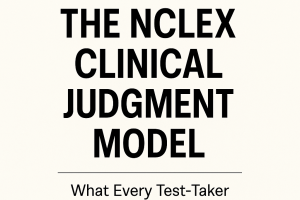Addison’s Disease and Cushing’s Syndrome: A Guide for NCLEX Exam

Endocrine disorders like Addison’s disease and Cushing’s syndrome are critical topics for the NCLEX exam. Both conditions involve dysfunction of the adrenal glands, leading to significant imbalances in hormone production. This guide will provide an overview of each disorder, including their causes, clinical manifestations, diagnosis, management, and nursing considerations, along with sample NCLEX questions to help you prepare.
Addison’s Disease
Addison’s disease is a rare but serious condition characterized by insufficient production of hormones by the adrenal glands, particularly cortisol and aldosterone. This can lead to a variety of systemic effects and requires prompt diagnosis and treatment.
Causes
- Autoimmune destruction: The most common cause, where the body’s immune system attacks the adrenal glands.
- Infections: Such as tuberculosis or fungal infections that damage the adrenal glands.
- Adrenal hemorrhage: Often due to anticoagulant therapy or severe stress.
- Adrenalectomy: Surgical removal of the adrenal glands.
- Medications: Long-term use of corticosteroids that are suddenly stopped.
Clinical Manifestations
- Fatigue: Persistent and worsening, due to low cortisol levels.
- Weight loss and anorexia: Resulting from decreased appetite and metabolic disturbances.
- Hyperpigmentation: Darkening of the skin, particularly in areas exposed to friction, due to increased ACTH (adrenocorticotropic hormone) levels.
- Hypotension: Low blood pressure, often orthostatic, due to decreased aldosterone.
- Hyponatremia and Hyperkalemia: Low sodium and high potassium levels due to impaired aldosterone function.
- Hypoglycemia: Low blood sugar levels, leading to dizziness, confusion, and weakness.
- Nausea, vomiting, and diarrhea: Common gastrointestinal symptoms.
- Salt craving: Due to low sodium levels.
Diagnosis
- ACTH Stimulation Test: Measures the adrenal glands’ response to synthetic ACTH. In Addison’s disease, cortisol levels will remain low despite stimulation.
- Serum Electrolytes: Typically show hyponatremia, hyperkalemia, and hypoglycemia.
- Cortisol Levels: Low serum cortisol levels, especially in the morning.
- Imaging: CT or MRI may be used to assess the adrenal glands for structural abnormalities.
Management
- Hormone Replacement Therapy:
- Hydrocortisone: The primary treatment for cortisol replacement.
- Fludrocortisone: A mineralocorticoid used to replace aldosterone.
- DHEA (Dehydroepiandrosterone): May be prescribed for women to improve quality of life and energy levels.
- Crisis Prevention:
- Educate patients to increase corticosteroid doses during periods of stress, illness, or surgery to prevent an adrenal crisis.
- Ensure patients wear a medical alert bracelet indicating their condition.
- Dietary Considerations:
- Encourage a diet high in sodium, especially in hot weather or during vigorous exercise.
- Emergency Management:
- Adrenal Crisis: Administer IV hydrocortisone, saline, and dextrose immediately in the event of an adrenal crisis, which can be life-threatening.
Cushing’s Syndrome
Cushing’s syndrome is a condition characterized by excessive levels of cortisol in the body, often due to prolonged use of corticosteroids or a tumor in the pituitary gland (Cushing’s disease) or adrenal glands.
Causes
- Exogenous Corticosteroids: The most common cause, due to long-term use of glucocorticoids for conditions like asthma, rheumatoid arthritis, or lupus.
- Pituitary Tumor (Cushing’s Disease): Causes increased secretion of ACTH, leading to excess cortisol production.
- Adrenal Tumors: Benign or malignant tumors of the adrenal glands that produce excess cortisol.
- Ectopic ACTH Production: Some cancers, like small-cell lung cancer, can produce ACTH outside the pituitary gland.
Clinical Manifestations
- Weight Gain: Particularly in the face (moon face), upper back (buffalo hump), and abdomen, with thin arms and legs.
- Skin Changes: Purple striae (stretch marks), bruising, thinning of the skin, and slow healing of cuts or infections.
- Muscle Weakness: Proximal muscle wasting, particularly in the thighs and shoulders.
- Osteoporosis: Increased risk of fractures due to weakened bones.
- Hypertension: Elevated blood pressure due to fluid retention.
- Hyperglycemia: High blood sugar levels, leading to diabetes or worsening existing diabetes.
- Mood Changes: Depression, irritability, and mood swings are common.
- Hirsutism: Excessive hair growth, particularly in women.
- Menstrual Irregularities: Including amenorrhea (absence of menstruation) in women.
Diagnosis
- 24-Hour Urine Cortisol Test: Measures the amount of cortisol excreted in the urine over 24 hours.
- Dexamethasone Suppression Test: Assesses how cortisol levels respond to dexamethasone, a synthetic glucocorticoid.
- Salivary Cortisol Levels: Late-night salivary cortisol levels are elevated in Cushing’s syndrome.
- Imaging: CT or MRI scans may be used to identify tumors in the pituitary or adrenal glands.
Management
- Medication:
- Ketoconazole, Metyrapone, Mitotane: Drugs that inhibit cortisol production.
- Pasireotide: A somatostatin analog used to treat Cushing’s disease by inhibiting ACTH production.
- Surgery:
- Transsphenoidal Surgery: Removal of pituitary tumors in Cushing’s disease.
- Adrenalectomy: Removal of one or both adrenal glands if they are the source of excess cortisol.
- Radiation Therapy:
- Used when surgery is not an option or has been unsuccessful, particularly for pituitary tumors.
- Gradual Withdrawal of Corticosteroids:
- If Cushing’s syndrome is due to exogenous corticosteroids, the medication should be tapered slowly under medical supervision to avoid adrenal insufficiency.
Nursing Considerations
For Addison’s Disease
- Monitor Vital Signs: Pay special attention to blood pressure and heart rate.
- Assess for Signs of Adrenal Crisis: Sudden severe pain in the lower back, abdomen, or legs, severe vomiting and diarrhea, dehydration, low blood pressure, and loss of consciousness.
- Patient Education: Teach patients about the importance of medication adherence, managing stress, and recognizing the signs of an adrenal crisis.
For Cushing’s Syndrome
- Monitor Blood Glucose Levels: As hyperglycemia is common, especially in patients with diabetes.
- Assess for Signs of Infection: Due to the immunosuppressive effects of excess cortisol.
- Patient Education: Discuss the importance of taking medications as prescribed, maintaining a healthy diet, and being aware of potential complications such as osteoporosis and hypertension.
Sample NCLEX Questions
Question 1
A patient with Addison’s disease is admitted with severe hypotension and confusion. Which of the following interventions should the nurse perform first?
A. Administer IV hydrocortisone.
B. Monitor blood glucose levels.
C. Start an IV infusion of 0.9% saline.
D. Administer oral fludrocortisone.
Answer: A. Administer IV hydrocortisone.
Question 2
Which clinical manifestation should the nurse expect to find in a patient with Cushing’s syndrome?
A. Hyperpigmentation
B. Hypotension
C. Truncal obesity
D. Hypoglycemia
Answer: C. Truncal obesity
Question 3
A patient with Cushing’s syndrome is scheduled for a transsphenoidal surgery to remove a pituitary tumor. Which postoperative complication should the nurse monitor for?
A. Diabetes insipidus
B. Hypoglycemia
C. Hyperkalemia
D. Addisonian crisis
Answer: A. Diabetes insipidus
NCLEX Preparation Tips for Addison’s Disease and Cushing’s Syndrome
- Understand Hormonal Imbalances: Focus on how cortisol and aldosterone imbalances affect the body in Addison’s disease and Cushing’s syndrome.
- Recognize Key Symptoms: Memorize the hallmark signs and symptoms of each condition, as they are frequently tested on the NCLEX.
- Practice with Case Scenarios: Applying your knowledge to case studies will help reinforce your understanding and prepare you for clinical situations.






